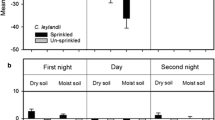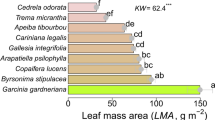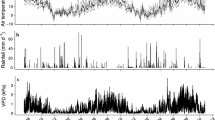Summary
The importance of high winter winds and plant temperatures as causes of winter desiccation damage at the alpine treeline were studied in the Austrian Alps. Samples of 1- and 2-year twigs of Picea abies and Pinus cembra were collected from the valley bottom (1,000 m a.s.l.), forestline (1,940 m a.s.l.), kampfzone (2.090 m a.s.l.), wind-protected treeline (2,140 m a.s.l.), and wind-exposed treeline (2,140 m a.s.l.). Cuticular transpiration was measured at three different levels of wind speed (4, 10, and 15 ms-1) and temperature (15°, 20°, and 25° C). At elevated wind speeds slight increases in water loss were observed, whereas at higher temperatures much greater increases occurred. Studies on winter water relations show a significant decline in the actual moisture content and osmotic potentials of twigs, especially in the kampfzone and at treeline. The roles of high winds and temperatures in depleting the winter water economy and causing desiccation damage in the alpine treeline environment are discussed.
Similar content being viewed by others
References
Aulitzky H (1961) Die Bodentemperaturen in der Kampfzone oberhalb der Waldgrenze und im subalpinen Zirben-Lärchenwald. Mitt Forstl Bundesversuchsanstalt Mariabrunn (Wien) 59:153–208
Baig MN, Tranquillini W, Havranek WM (1974) Cuticuläre Transpiration von Picea abies- und Pinus cembra-Zweigen aus verschiedener Seehöhe und ihre Bedeutung für die winterliche Austrocknung der Bäume an der alpinen Waldgrenze. Cbl ges Forstwesen 91:195–211
Baig MN, Tranquillini W (1976) Studies on upper timberline: morphology and anatomy of Norway spruce (Picea abies) and stone pine (Pinus cembra) needles from various habitat conditions. Can J Bot 54:1622–1632
Caldwell MM (1970) The wind regime at the surface of the vegetation layer above timberline in the Central Alps. Cbl ges Forstwes 87:65–74
Firbas F (1931) Die Wirkung des Windes auf die Transpiration. Ber deutsch Bot Ges 49:443–452
Gates DM (1976) Energy exchange and transpiration. In: OL Lange, L Kappen, ED Schulze (eds) Water and plant life. Ecological studies, Springer Berlin Heidelberg New York 19: 137–147
Gäumann E, Jaag O (1936) Untersuchungen über die pflanzliche Transpiration. Ber schweiz Bot Ges 45:411–518
Holmgren P, Jarvis PG, Jarvis MS (1965) Resistance to carbon dioxide and water vapour transfer in leaves of different species. Physiologia Pl 18:557–573
Klikoff LG (1965) Microenvironmental influence on vegetational pattern near timberline in the central Sierra Nevada. Ecol Monogr 35:187–211
Lindsay JH (1963) Annual cycle of leaf water potential in Picea engelmannii and Abies lasiocarpa at timberline in Wyoming. Arctic and Alpine Res 3:131–138
Marchand PJ, Chabot PF (1978) Winter water relations of treeline plant species of Mt. Washington, New Hampshire. Arctic and Alpine Res 10:105–116
Michaelis P (1934a) Ökologische Studien an der alpinen Baumgrenze. II. Die Schichtung der Windgeschwindigkeit, Lufttemperatur und Evaporation über einer Schneefläche. Beih Bot Cbl 52B:310–332
Michaelis P (1934b) Ökologische Studien an der alpinen Baumgrenze. III. Über die winterlichen Temperaturen der pflanzlichen Organe, insbesondere der Fichte. Beih Bot Cbl 52B:333–337
Michaelis P (1934c) Ökologische Studien an der alpinen Baumgrenze. IV. Zur Kenntnis des winterlichen Wasserhaushaltes. Jb wiss Botan 80:169–247
Moreshet S (1970) Effect of environmental factors on cuticular transpiration resistance. Plant Physiol 46:815–818
Pisek A, Berger E (1938) Kutikuläre Transpiration und Trockenresistenz isolierter Blätter und Sprosse. Planta (Berl) 28:124–155
Pisek A, Winkler E (1953) Die Schließbewegung der Stomata bei ökologisch verschiedenen Pflanzentypen in Abhängigkeit vom Wassersättigungszustand der Blätter und vom Licht. Planta (Berl) 42:253–278
Platter W (1976) Wasserhaushalt, cuticuläres Transpirationsvermögen und Dicke der Cutinschichten einiger Nadelholzarten in verschiedenen Höhenlagen und nach experimenteller Verkürzung der Vegetationsperiode. Ph D thesis, University of Innsbruck
Sakai A (1966) Temperature fluctuation in wintering trees. Physiol Plant 19:105–114
Slatyer RO (1976) Water deficits in timberline trees in the Snowy Mountains of south-eastern Australia. Oecologia (Berl) 24:357–366
Slatyer RO, Bierhuizen JF (1964) Transpiration from cotton leaves under a range of environmental conditions in relation to internal and external diffusive resistances. Austr J Biol Sci 17:115–130
Stålfelt MG (1932) Der Einfluß des Windes auf die kutikuläre und stomatäre Transpiration, Svensk Bot Tidskr 26:45–69
Tranquillini W (1974) Der Einfluß von Seehöhe und Länge der Vegetationszeit auf das cuticuläre Transpirationsvermögen von Fichtensämligen im Winter. Ber deut Botan Ges 87:175–184
Tranquillini W (1976) Water relations and alpine treeline. In Ecological studies, Vol 19 Water and plant life OL Lange, L Kappen and ED Schulze (eds), p 473–491. Springer Berlin-Heidelberg-New York
Tranquillini W (1979) Physiological ecology of the Alpine timberline. Ecological studies 31, Springer Berlin-Heidelberg-New York p 137
Tranquillini W, Turner H (1961) Untersuchungen über die Pflanzentemperaturen in der subalpinen Stufe mit besonderer Berücksichtigung der Nadeltemperaturen der Zirbe. Mitt Forstl Bundesversuchsanstalt Mariabrunn 59:127–151
Tranquillini W, Machl-Ebner I (1971) Über den Einfluß von Wärme auf das Photosynthesevermögen der Zirbe (Pinus cembra L.) und der Alpenrose (Rhododendron ferrugineum L.) im Winter. Rep Kevo Subarctic Res Stat 8:158–166
Wardle P (1968) Engelmann spruce (Picea engelmannii Parry) at its upper limit on the Front Ranges, Colorado. Ecology 49:483–495
Wardle P (1971) An explanation for alpine timberline. NZJ Bot 9:371–402
Wrenger M (1935) Über den Einfluß des Windes auf die Transpiration der Pflanzen Zeitschr Bot 29:257–320
Author information
Authors and Affiliations
Rights and permissions
About this article
Cite this article
Baig, M.N., Tranquillini, W. The effects of wind and temperature on cuticular transpiration of Picea abies and Pinus cembra and their significance in dessication damage at the alpine treeline. Oecologia 47, 252–256 (1980). https://doi.org/10.1007/BF00346828
Received:
Issue Date:
DOI: https://doi.org/10.1007/BF00346828




